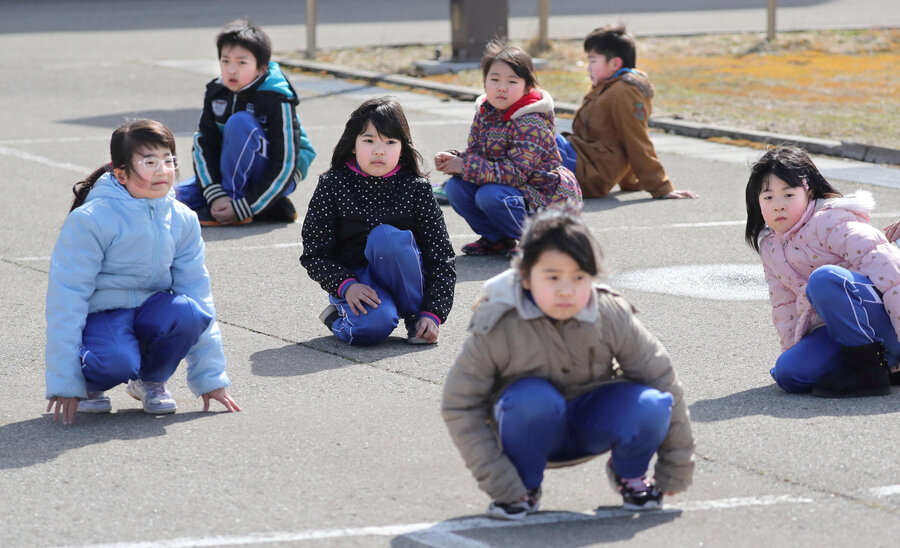How is Japan readying itself against an unpredictable North Korea?
Loading...
Residents of Japan’s northwestern city of Ogo performed a civilian evacuation drill on Friday, the country’s first, in preparation for a scenario in which ballistic missiles – launched by a country that went unnamed by the city’s disaster authorities – were to fall close to shore.
More than 100 residents and schoolchildren of the coastal city of Oga in northern Japan participated in the drill, with loudspeakers warning at 9:30 a.m. of a possible missile threat and urging residents to stay indoors or seek shelter inside a school or community center.
The exercise comes in response to a string of weapons tests by North Korea that have sent ballistic missiles into Japanese territorial waters in recent months, alarming authorities. And it’s one of several measures being contemplated by Japan, stirring up debate over how far its authorities should stretch a constitutional commitment to pacifism in preparing to defend its citizens from a North Korean attack. The intensifying threat from North Korea has added new pressure to a central question of the Abe years: Is the world finally ready for a more militarized Japan?
Since August, North Korea has shot ballistic missiles into waters administrated by Japan on three occasions. It described the last of those launches, on March 6, as a test of its capacity to strike US military targets in Japan.
Before that, the threat from North Korea was taking something of a backburner to disputes with China in the East China Sea, says Yuki Tatsumi, the East Asia program senior associate at the international peace and security think tank Stimson Center in Washington, D.C.
“The situation has drastically changed in the last four weeks, and this changes the calculus for the Japanese government and defense establishment in terms of what kind of role they should be playing if something really bad happens on the Korean peninsula,” she tells The Christian Science Monitor.
It has also amplified calls to develop the capacity to preemptively attack North Korean missile bases, using weapons such as cruise missiles or precision-guided bombs.
If Japan were to detect an imminent missile launch at the sites, says Ms. Tatsumi, “the government would probably make an argument that, assuming from past behavior, it’s either against Japan or US bases in Japan, which is in Japanese territory, and they have to take it out before they do it.”
It’s the most fraught of measures being contemplated by Japan, which has sent high-tech ships to the areas where North Korean missiles fell, as well as expanding intelligence sharing with South Korea. It will also soon dispatch its Izumo warship – a helicopter carrier classified as a destroyer to skirt a constitutional prohibition against the acquisition of offensive weapons – on a tour of the South China Sea, in a show of force not seen since World War II that has irritated China.
"If bombers attacked us or warships bombarded us, we would fire back. Striking a country lobbing missiles at us is no different," said Itsunori Onodera, former defense minister from the ruling Liberal Democratic party, in an interview with Reuters. "Technology has advanced and the nature of conflict has changed."
Prime Minister Shinzo Abe, who believes Article 9, in which Japan "renounces war as a sovereign right of the nation," should be done away with entirely, has done much to unbind the country’s military even as he works to establish conciliatory relations around the globe. In addition to creating a National Security Council and passing a state secrecy law designed to increase intelligence cooperation with the United States, as the Diplomat notes, Mr. Abe’s government also pushed through a hugely controversial overhaul in 2015 that permitted Japan’s Self-Defense Forces (SDF) to defend allies even if national territory isn’t attacked.
A clear majority of Japanese voters opposed the 2015 overhaul, which generated mass protests that reemerged as late as the one-year anniversary of the bill’s passage. North Korean provocations aside, self-defense capacities that toe the line of offense might be greeted with trepidation, says Tatsumi.
"I can see the same people who opposed that bill coming out again saying, 'this is a step toward the 1930s.'"
The debate comes as the Trump administration signals its readiness to pursue an aggressive new line with North Korea.
On a visit to Tokyo, US Secretary of State Rex Tillerson said on Thursday that diplomatic efforts to dissuade North Korea from developing nuclear weapons had been a “failed approach,” according to NBC. And in South Korea on Friday, Mr. Tillerson did not rule out military action against Pyongyang.
"If they elevate the threat of their weapons program to a level that we believe requires action then that option is on the table," he told reporters there.
That option would almost certainly have to be taken in close consultation with Japan, notes Tatsumi, right down to efforts to evacuate US citizens from South Korea.
“For Japan, North Korea really does weigh heavy,” she tells the Monitor. “These recent events are really reminding Japanese leaders … that yes, North Korea is there. And its threat can really be imminent.”
This report contains material from the Associated Press.






